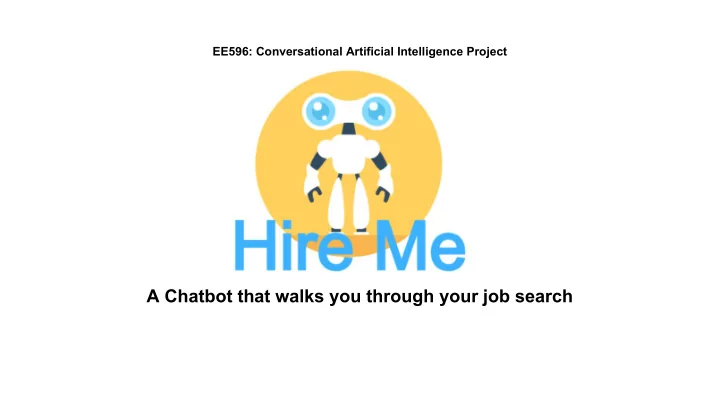

EE596: Conversational Artificial Intelligence Project A Chatbot that walks you through your job search
Overview 1. Motivation 2. System Architecture 3. Dialog Design and State Machine 4. Knowledge Database 5. Data Processing 6. Sample Dialogs 7. Observations 8. Takeaways 9. Future Work 2
Conversational Search The challenge: Context “It didn’t use contextual information so there was no way to expand on the previous answer it gave me." Participant commenting on their experience. (Vtyurina el al.'s 2017 work on Conversational Search) Formulating a full question takes effort and is unnatural. 3
Motivation Team Vision: ● Job Data challenging (yet tractable) ● Talk the user through a job search ● Develop a conversational system Target Users: New Job Seekers, people changing careers or job seekers who are new to the industry Team aims: ● Tech Learning Opportunity (AWS) ● Conversational Knowledge Base Navigation ● Context Dependant Response 4
System Architecture
Dialog Design Mega-states and their allowed actions: ● Greeting - Conversation w/o context slot filling, Help, Confirm and Decline ● Negotiation - Conversation with slot filling, Confirm, Decline, Backup, Reset ● Termination - Conversation with slot filling, Confirm, Decline, Backup, Reset Action Description: ○ Confirm: <yes words/sentences> ○ Decline: <no words/sentences> ○ Backup: Skip/Next and Confirm/Decline ○ Reset(Cancel): Reverts the conversation state to the filling the first context slot Dialog driver: data-defined context slots 6
State Machine 7
Job Knowledge Base ● Small data set for prototyping: 400 jobs (20 industries x 20 jobs) ● Rich for dialog experimenting ● Modelled as Limited Domains 8
Data Processing Current scope of system: ● Clustering: simple grouping by domain ● String normalization: e, e, è, é, ê, ë ● Data Standardization: analysis driven towards matching user utterance punctuation, abbreviations: mostly unchanged written: St Louis spoken: Saint Louis ● Search: using exact token matching Future scope: Reverse indices, Named-entity resolution, Entity linking/resolution, typo-fixing 9
Context-based Search Example "Top skills": Context Driven context = {} context = {city=California} ( 'risk management' , 20 ) ( 'policy development' , 4 ) ( 'key account management', 19 ) ( 'budget oversight' , 3 ) ( 'p l management' , 19 ) ( 'corporate security' , 3 ) ( 'project planning' , 19 ) ( 'cost accounting' , 3 ) 10
Sample dialog A end-to-end dialog sample shown here 11
Language Generation Rule-based Response Generator: directs to apt response based on the turn goal 12
Observations ● Alexa intent recognition algorithm is heavily dependent upon: ○ Number of words in the utterances ○ The utterance vocabulary ○ Number of samples in each slot ● Alexa ASR does not : recognize sentence boundaries, perform well with named entity words that are commonly referred to with abbreviations, i.e., AT&T. ● Built-in intents handle disfluencies well when supplemented with sufficient sample utterance data, but do not handle backup and corrections, i.e., “I want to work in Portland uh I mean Seattle” ● A slot-filling approach is a naive but effective approach to building an information retrieval chatbot ● Wake words such as ‘Alexa’ cannot be recognized in any utterance 13
Suggested Evaluation Naive approach: ● % of search restarts ● % of turns per slot ● % of session “quits” without entering Termination state Future Scope: Formal methods such as the PARADISE framework 14
DEMO 15
Takeaways ● Alexa ASR is robust and easy to work with ● Dialog model could be made more flexible ● Decouple NLU from interaction model ● Data model has great potential for research 16
Future Scope Dialog Policy: transform system to mixed-initiative system; incorporate Markov processes to maintain information state. NLU Robustness: allow user to fill multiple context slots in a single utterance; map user preferences using context slot clustering in database; use RNNs to identify user utterances and map them to intents. NLG Improvement: change current rule-based system to a neural sequence model. Entity Resolution: disambiguate between named entities. Additional Features: allow user to change existing context slot values at any point; send email to user containing job application links 17
18
Recommend
More recommend